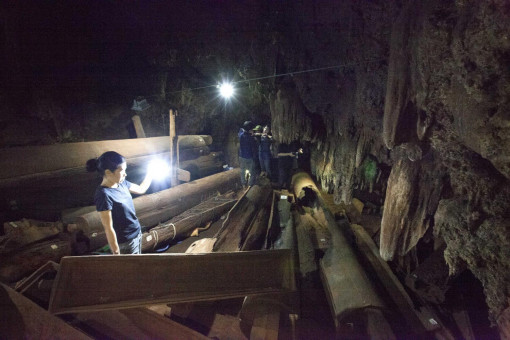Ancient human DNA linked to modern ethnic groups, prehistoric migration

DNA decoding from 33 pieces of ancient human bones and teeth found at Iron Age Log Coffin sites in Mae Hong Son province is showing a link between prehistoric communities and modern ethnic groups in the region, according to an expert.
Rasmi Shoocongdej, a lecturer at the Faculty of Archaeology, Silpakorn University, and head of the Prehistoric Population and Cultural Dynamics in Highland Pang Mapha Project, said her team has been surveying a prehistoric cave community in Mae Hong Son since 1998 to learn more about prehistoric migrations in the area.
The highlands of Pang Mapha were a mortuary for ancient humans who lived in the area and they followed the “Log Coffin” culture. Large coffins carved from teak wood dating between 1,000 to 2,300 years ago have been discovered in about 40 caves and rock shelters in the province.
“While previous studies focused on the cultural development of Log Coffin-associated sites, the origins of the practice, connections with other wood coffin-using groups in Southeast Asia and the social structures in the region remained unstudied,” Prof Rasmi said.
“So, we present genome-wide data from 33 individuals from five Log Coffin culture sites to study genetic ancestry profiles and genetic interconnectedness,” she said.
The team worked closely with the Max Planck Institute for Evolutionary Anthropology in Leipzig, Germany, to study DNA from 33 bones and teeth of ancient individuals found at the five sites, she said.
The results showed new connections between individuals from the five sites, she said, adding a report on the discovery was published in Nature Communication in December.
She said the discovery could create a better understanding of ethnic groups in the Asian region, including Thailand.
“It shows a migration route humans took during the prehistoric period,” she said.
Pang Mapha ancient humans shared a close DNA pattern with Neolithic people who lived in the Yangtze River Valley and Yellow River Valley in China, she said. It is believed that they migrated from China to the western part of the Salween River, she said. “Our research examines the relationship between humans and their environments in the seasonal tropics,” she said.
“Our [mission] is the exploration of the social structure of these prehistoric communities and explaining their connections with other pre-Neolithic and post-Neolithic groups in this region.”
Wibhu Kutanan, a scientist at Naresuan University, said analysing the DNA of ancient humans is challenging because bones and other genetic materials deteriorate over time.
However, the team was lucky to have found 33 “perfect” pieces out of the 66 that were sent to a lab in Germany for analysis, Assoc Prof Wibhu said.
The samples were good enough to run identical-by-descent block analysis, a method that helped trace complex biological patterns in the region, he said.
The team was among the first to use the method in archaeogenetics studies of Southeast Asia, he noted.
“This is a first in the Southeast Asia region to have a DNA test to identify individual relations in ancient times,” he said.
“The result is so amazing as we have found family relations, including twins, half-siblings, grandfathers and grandchildren.
“We have also seen great-grandfather relations between the Yappa Nhae II cave and the Tham Lod cave [in Mae Hong Son],” he said.
The study, he added, has also concluded that ancient Pang Mapha humans shared similar DNA patterns to Lava, Mon and Padong Karen ethnic groups.
The result is significant since log coffins were also used by prehistoric peoples in Southeast Asia, he said, noting that the project could help explain cultural dynamics and population interactions in Southeast Asia and other regions.
Prof Rasmi said the team will explore archaeological sites in the Central Plains provinces of Lop Buri and Suphan Buri, which are believed to have contained major prehistoric communities.
The study is an attempt at finding “the missing piece of a jigsaw puzzle” that could reshape understanding of ancient Thai culture from the Dvaravati era (6th–11th century) to the present Rattanakosin period.

